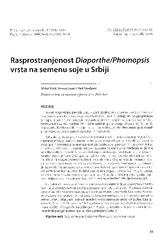Приказ основних података о документу
Distribution of seed borne Diaporthe/Phomopsis species in soybean in Serbia
Rasprostranjenost Diaporthe/Phomopsis vrsta na semenu soje u Srbiji
| dc.creator | Vidić, Miloš | |
| dc.creator | Jasnić, Stevan | |
| dc.creator | Đorđević, Vuk | |
| dc.date.accessioned | 2021-04-26T18:10:07Z | |
| dc.date.available | 2021-04-26T18:10:07Z | |
| dc.date.issued | 2006 | |
| dc.identifier.issn | 1820-3949 | |
| dc.identifier.uri | http://fiver.ifvcns.rs/handle/123456789/377 | |
| dc.description.abstract | Soybean seed samples were analyzed for the presence of seed borne fungi from the genus Diaporthe/Phomopsis in the period 2002-2004. The samples were collected following a geographical principle, from large-plot trials located in the main soybean-growing regions of Serbia. The study included four soybean cultivars from different maturity groups: Afrodita (O), Balkan (I), Vojvođanka (II) and Morava (III). Isolation on nutritive medium (PDA) and determination of the isolated fungi were performed using conventional phytopathological methods. it was shown that parasites from the genus Diaporthe/Phomopsis were present in most soybean-growing regions of Serbia. Intensity of seed infection varied considerably depending on year and location. For example, an intensive infection (over 65% in some samples) was registered in 2002, while very weak infection was found in 2003 (Tables 1, 2 and 3). Large differences were found between disease intensities per location in the same year. The year 2002 was characteristic i-that respect, with no infection on several locations and high percentage of infected seed on others. Obviously, the intensity of seed infection with fungi from the genus Diaporthe/Phomopsis is determined mostly by weather conditions. Continual high air humidity and temperature from the beginning of soybean maturation till harvest encourage the infection and development of seed decay. Accordingly, high infection rates were registered in the rainy year of 2002 and in humid regions, especially along large rivers. The presence of two varieties of the fungus Diaporthephaseolorum, i.e., D. phaseolorum var. caulivora, the agent of soybean stem canker, and D. phaseolorum var. sojae, anamorph Phomopsis sojae, the agent of pod and stem blight, as well as of the species Phomopsis longicolla, the agent of soybean seed decay, was confirmed in the analyzed seed samples. These pathogens had already been reported on soybean seeds in Serbia. The intensity of their occurrence depends on year, location and cultivar (Figs. 1, 2 and 3). For example, D. phaseolorum var. caulivora predominated in 2002, P. longicolla in 2003 and P. sojae in 2004. On the three-year average, the presence of these seed pathogens was fairly uniform (Fig. 3). | en |
| dc.description.abstract | Tokom trogodišnjeg perioda (2002 - 2004. godine) analizirani su uzorci semena soje na prisustvo parazita iz roda Diaporthe/Phomopsis. Uzorci su prikupljeni po geografskom principu, iz sortnih makroogleda lociranih u glavnim regionima gajenja soje u Srbiji, istraživanjima su obuhvaćene četiri sorte različitih grupa zrenja; Afrodita (0), Balkan (l), Vojvođanka (II) i Morava (III). Izolacije na hranljivu podlogu (PDA) i determinacija izolovanih gljiva vršene su uobičajenim fitopatološkim metodama. Pokazalo se da su paraziti ovog roda prisutni u većini regiona gajenja soje u Srbiji. Intenzitet infekcije semena znatno varira u zavisnosti od godine i lokaliteta. Tako je u 2002. godini konstatovana veoma jaka zaraza (preko 65%, u pojedinim uzorcima), dok se u sledećoj, 2003. godini, pojavila samo u tragovima (tabele 1, 2 i 3). Međutim, evidentne su velike razlike u intenzitetu pojave oboljenja između pojedinih lokaliteta, u istoj godini. Karakterističan primer je 2002. godina, kada na nekoliko lokaliteta nije bilo infekcije semena, dok je na drugim procenat zaraženih zrna vrlo visok. Očigledno je da intenzitet infekcije semena parazitima iz roda Diaporthe/Phomopsis u najvećoj meri opredeljuju vremenski uslovi. Naime, utvrđeno je da kontinuirana vlažnost i povišena temperatura vazduha, od početka sazrevanja useva do žetve soje veoma pogoduju nastanku infekcije i širenju truleži semena. Shodno tome, potpuno je razumljivo da u kišovitoj 2002. godini, kao i humidnijim regionima koji gravitiraju većim rekama, intenzitet infekcije bude najjači. Iz analiziranih uzoraka semena izdvojena su dva varijeteta gljive: Diaporthe phaseolorum, i to: D. phaseolorum var. caulivora, prouzrokovač raka stabla soje i D. phaseolorum var. sojae, anamorf Phomopsis sojae, prouzrokovač paleži mahuna i stabla, kao i vrsta Phomopsis longicolla, prouzrokovač truleži semena. Svi pomenuti i paraziti već su ranije opisani na semenu soje u Srbiji. Zastupljenost navedenih vrsta varira u zavisnosti od godine, lokaliteta i sorte (Slike. 1,2 i 3). Tako je u 2002. godini najčešće izolovana D. Phaseolorum var. caulivora, u 2003. - R longicolla, a u 2004. godini P sojae. U prošeku za tri godine zastupljenost navedenih patogena semena je prilično ujednačena (Slika 3). | sr |
| dc.publisher | Institut za pesticide i zaštitu životne sredine, Beograd i Društvo za zaštitu bilja Srbije, Beograd | |
| dc.rights | openAccess | |
| dc.rights.uri | https://creativecommons.org/licenses/by-sa/4.0/ | |
| dc.source | Pesticidi i fitomedicina | |
| dc.subject | soybean | en |
| dc.subject | soybean seed | en |
| dc.subject | Diaporthe/Phomopsis | en |
| dc.subject | distribution | en |
| dc.subject | soja | sr |
| dc.subject | seme soje | sr |
| dc.subject | Diaporthe/Phomopsis | sr |
| dc.subject | rasprostranjenost | sr |
| dc.title | Distribution of seed borne Diaporthe/Phomopsis species in soybean in Serbia | en |
| dc.title | Rasprostranjenost Diaporthe/Phomopsis vrsta na semenu soje u Srbiji | sr |
| dc.type | article | |
| dc.rights.license | BY-SA | |
| dc.citation.epage | 48 | |
| dc.citation.issue | 1 | |
| dc.citation.other | 21(1): 39-48 | |
| dc.citation.spage | 39 | |
| dc.citation.volume | 21 | |
| dc.identifier.fulltext | http://fiver.ifvcns.rs/bitstream/id/1228/374.pdf | |
| dc.identifier.rcub | https://hdl.handle.net/21.15107/rcub_fiver_377 | |
| dc.type.version | publishedVersion |


